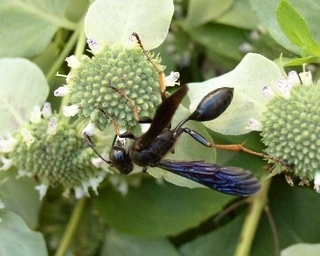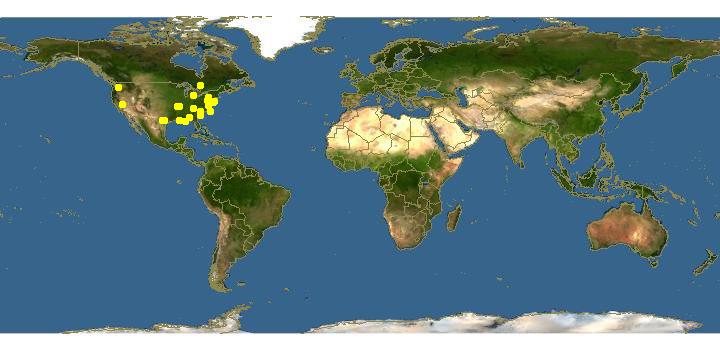
© Beatriz Moisset, Bugguide.net · 9
Isodontia auripes |

Click on map for details about points.
|
|
Overview |
Taken from:
Bohart, R.M., Menke, A.S. 1963. A Reclassification of the Sphecinae: With a Revision of the Nearctic Species of the Tribes Sceliphronini and Sphecini.
Male—Average length 18 mm; black; apex of bind femur, tibiae, and tarsi reddish brown; wings dark violaceous; erect hair of head and thorax off-white to brownish or black; face, pronotal ridge, and metapleuron above hind coxa with appressed silver pubescence; sternites IV—VII with transverse bands of brown cilia; flagellomere I slightly longer than II; flagellomeres IV—VI spiculate; apex of sternite VIII emarginate; genitalia about as in figure 65.
Female.—Average length 19 mm; fore and mid tibiae and tarsi reddish brown or brown,
Bohart has studied the type of tibialis.
|
|
|
Names | |
Isodontia (Murrayella) auripes (Fernald)
(Fig. 20)
Sphex tibialis Lepeletier, 1845, Hist. Nat. Insect., Hymen., 3:339. Holotype ♀, Philadelphie” (TURIN). Preoccupied by Sphex tibialis Fabricius 1781.
Chlorion auripes Fernald, 1906, Proc. United States Natl. Mus., 31:356. New name for Sphex tibialis Lepcletier, 1845.
|
|
|
Geographic distribution | |
Distribution.—This species occurs in the eastern United States, south of the
Great Lakes and east of the 100th meridian (fig. 20).
|
|
|
Natural history | |
Biology.—Rau (1928b) observed auripes nesting in the burrows of Melitoma taurea (Say) and Anthophora abrupta Say (Anthophoridae) in a bluff. Rau also recorded nests in carpenter bee burrows and sumac stems. Prey consisted of Gryllidae (Oecanthus quadripunctatus Beutenmuller, O. latipennis Riley) and conocephaline Tettigoniidae (Conocephalus memorale Scudder, Orchelimum vulgare Harris).
|
|
| Supported by | |
Updated: 2024-04-19 04:57:42 gmt
|